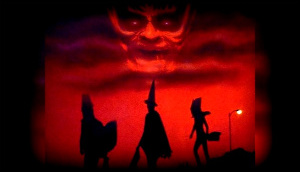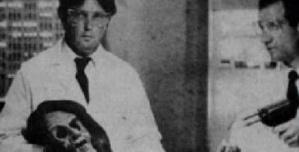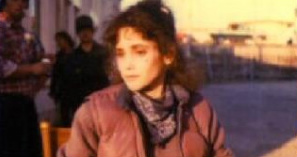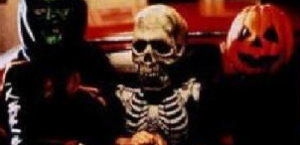
Director: Tommy Lee Wallace
Writers: Tommy Lee Wallace, Nigel Kneale
Starring: Tom Atkins, Stacey Nelkin, Dan O’Herlihy, Michael Currie
Rating: R (USA), 15 (UK), M (Australia)
Instead of ‘The Night He Came Home,’ the tagline for Halloween 3: Season of the Witch was the more appropriate ‘The Night No On Came Home.’ The second sequel was by far the most nihilistic of all the stories and would take a drastic departure away from the slasher formula and more into an eighties blend of old school anthology and Invasion of the Body Snatchers. With the likes of the Friday the 13th movies and their countless imitators scoring at the box office, producers Irwin Yablans and Moustapha Akkad once again discussed the possibility of returning to the franchise and contacted the principal players about another project. Jamie Lee Curtis, whose character Laurie Strode had been exhausted in the previous entry, had no intention of portraying the character once again and so John Carpenter and Debra Hill, who had been the creative force behind the first two films, were forced the approach a sequel from a new angle. In fact, the two had only agreed to return on the condition that they could take the series in a new direction, having felt disappointed by the experience of Halloween 2, and so a decision was made that the next film would deviate completely from the slasher genre.
Nigel Kneale was a Manx screenwriter who had been responsible for the cult BBC series The Quatermass Experiment in 1953 which had then been adapted by Hammer as The Quatermass Xperminent two years later. An influential and prolific writer, Kneale had enjoyed a successful career that included an adaptation of H.G. Wells’ First Men in the Moon and countless Quatermass sequels and tie-ins. Carpenter had been deeply inspired by him as he had developed his own talents as a storyteller and so as the prospect of creating something new and exciting with Halloween 3 was too good an opportunity to pass up and so decided to contact the writer regarding the possibility of developing a new story. At the time, Kneale had been in Los Angeles performing rewriters on a proposed 3D remake of the fifties classic Creature from the Black Lagoon for director Jack Arnold and executive producer John Landis. Enthusiastic about the project, Kneale returned to Carpenter and Hill just a mere three hours after the proposition with a story outline, before returning to London where he would spend a further three weeks adapting the concept into a screenplay. In 1960, when Kneale believed that he was dying from an unknown disease, he had penned a story entitled The Big Giggle, in which a nation is shocked by a sudden wave of teenage suicides. Intended as a serial, the studio were apprehensive about the project in case its broadcast coincided with any real-life suicides, to which the show could be used as a scapegoat, and so the idea was jettisoned. The basic premise though, of a bizarre epidemic of deaths ricocheting through the the nation’s children, would perform the basis for his new screenplay, that was penned under the working title Halloween 3, though Kneale hoped that it would be produced independently from the franchise.

When Carpenter and Hill read the second draft of the script, they decided that the material was too dark and cynical and lacked a commercial appeal and so decided to rework the story themselves, much like they had done to Rick Rosenthal’s cut of Halloween 2 the previous year. As with before, Carpenter approached regular collaborator Tommy Lee Wallace with the suggestion of directing although, unlike before, he finally accepted, adding his own rewrites to the screenplay, including the addition of various references to British monument Stonehenge. Instead of focusing on Michael Myers, Halloween 3 instead told the story of an alcoholic but well-meaning doctor Dan Challis, whose late night shift at the hospital is disturbed by the arrival and subsequent murder of deranged shop owner Harry Grimbridge. Along with the victim’s daughter, Ellie, Dan begins to investigate the events leading up to the man’s death, the only clue being a jack-o’-lantern mask that the man was clutching. Produced by the mysterious firm Silver Shamrock, the masks have enjoyed a popular television campaign and soon Dan and Ellis discover that the company’s owner, Conal Cochran, intends on killing the world’s child population by deadly TV signals that will transmit into all the masks on Halloween. The two head to the company’s town of Santa Mira where they discover a population of androids that act as Cochran’s assassins.
There are several key influences behind the story for Halloween 3. The town which Silver Shamrock operate from, Santa Mira, takes its name from Santa Mira from Don Siegel’s fifties classic Invasion of the Body Snatchers, which told of Miles Bennell, a doctor in a small Californian town, who uncovers a conspiracy where the locals are being replaced by imposters of extraterrestrial origin. The film would also provide Halloween 3 with several of its key plot points, as well as employing a similar atmosphere. Another inspiration was Kneale’s own 1957 feature Quatermass 2, which he co-scripted with director Val Lewton. The follow up to his breakthrough success, the story focused on a series of meteorite crashes which brings the eponymous hero to a small town to discover a mysterious complex being constructed. The concept of a sinister enterprise having a bizarre hold over the locals is echoed in the portrayal of Silver Shamrock in Halloween 3. The original draft of Kneale’s script saw Dr. Challis presenting his own children with the Halloween masks, though this was adapted during the rewrites in order to make him more of a hero.

One major departure for Halloween 3 was that the story would focus on adults instead of sexually promiscuous teenagers. Despite this, there are a few shots that Wallace would employ throughout the movie that would resemble certain elements of Carpenter’s film, and a cameo from Halloween 2‘s Dick Warlock as an assassin who executes Harry Grimbridge before burning himself alive, along with uncredited vocal contributions from Jamie Lee Curtis and Wallace, at least provide minor connections to its predecessors. For the role of Challis, Carpenter approached Tom Atkins, a veteran genre actor whom he worked with previously on The Fog and Escape from New York, whilst the role of the creepy villain Cochran would be taken by Dan O’Herlihy, who would later find fame in the Robocop movies. The supporting cast would include Michael Currie (who had appeared in the similarly themed Dead and Buried in 1981), Ralph (The Beastmaster) Strait and Carpenter regular (and Wallace’s wife) Nancy Loomis.
For the Silver Shamrock factory, the filmmakers had acquired the use of the Familiar Foods milk factory in Loleta, but when health regulations meant that they would be unable to create any kind of explosions and other effects required for the movie, they were forced to find a new location, finally settling on Don Post Studios, who had also been responsible for designing the three masks that would be used for the film. These included a Hagatha the Witch and a phosphorescent skull, which were both modified together to create the pumpkin head that would be used to promote the film. Coincidentally, these three masks would also be released commercially, their designs based on the originals by Don Post Studios. Halloween 3 had been budgeted at approximately $2.5m and was shot in and around Loleta and Sierra Madre, California. Despite Carpenter only performing producer duties, the direction and atmosphere of Halloween 3 was very akin to his style at that point, echoing moments of his previous works. In fact, the opening sequence in which Harry Grimbridge is chased through a car park by an android assassin was originally to have been shot in the desert but budgetary restrictions forced the filmmakers to rewrite the scene, which now resembled Carpenter’s Assault on Precinct 13.

When Kneale discovered the drastic changes that had been made to his work he was furious and demanded that his name be removed from the credits, even threatening legal action against the producers. He also expressed issues over the violent content of the movie, although his own drafts featured its fair share of offensive material (including a xenophobic attitude towards the Irish, with its portrayal of the creepy Cochran. Kneale also stated that the film concentrated too much on gore instead of magic and suspense, as he had intended. With the story no longer focusing on Michael Myers or Haddonfield, Carpenter decided it was time to rewrite the score instead of reusing his music from the original and collaborated with Escape from New York‘s Alan Howarth on a synthesiser score that seemed more in key with Carpenter’s more common work. Despite the negative setbacks with the original writer, the filmmakers felt confident that they had made the right decisions and by October 1982 it was time to test the waters with the fanbase.
Halloween 3: Season of the Witch‘s opening weekend in America earned $6,333,259, almost one million short of what Halloween 2 had achieved but still a respectable amount. Whereas with the previous instalment, the main negativity came from critics, this time it was the fans themselves who were disappointed that the filmmakers had changed the formula and ignored the previous films. Plans for Carpenter and Hill’s proposed horror anthology were abandoned and the franchise came to a standstill, with Carpenter moving onto work on the Stephen King adaptation Christine. Over the years, Halloween 3 has gained a loyal following and is considered by many to be an enjoyable monster movie in its own right, with some preferring to ignore the Halloween title all together. It would be another six years before the series would be resurrected, with the story of Silver Shamrock permanently laid to rest.


9 Responses to HE CAME HOME pt.3 – Halloween 3: Season of the Witch (1982)